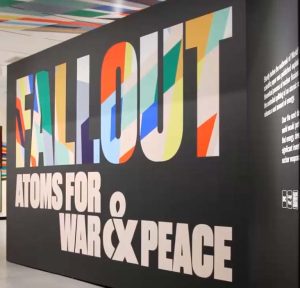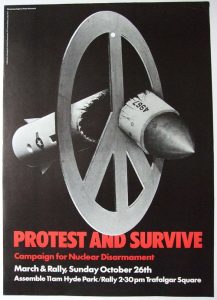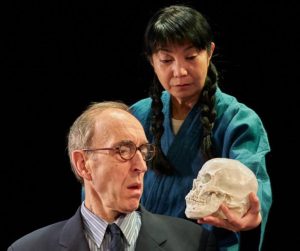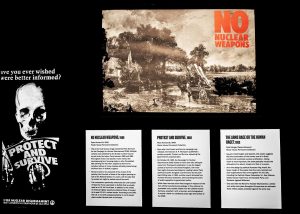Activism against nuclear weapons got me my second arrest and pushed me further into war tax resistance. It was the late 70s into the 80s, the time of Reagan’s military build-up, nuclear threats, and No Nukes: The MUSE Concerts For a Non-Nuclear Future to inspire activism.* Over the years artists of all genres have used their skills to protest nuclear assured destruction. Recently my cultural travels have involved something of a lead-in to August 6 and 9 and the 80th year of the nuclear age.
A couple months ago I was lucky enough to see a play called The Mistake. The British playwright and actor, Michael Mears, was moved to create this play after hearing the stories of Hibakusha, survivors of the Hiroshima and Nagasaki bombings. With 80 years since the bombings, the youngest survivors are in the 80s now, which makes it important to keep telling their stories in new ways until the last nuclear weapon has been dismantled. The Mistake manages to do this with two actors, an imaginative set, and the actual words of three people:
Shigeko Nomura is a young woman living in war-time Hiroshima.
Leo Szilard is a Hungarian scientist and ‘father of the atomic bomb’.
Paul Tibbets is the American pilot chosen to fly the plane that drops the bomb.
At 8.15am on a Monday morning in August, their lives become fatally and forever entangled.
Tibbets. He never regretted delivering the bomb — or naming the plane after his mother apparently, which Utah Phillips addresses in his beautiful song, “Enola Gay” .
 Further cultural adventures led me to “Fallout: Atoms for War and Peace,” an exhibit at Poster House in New York City. It starts with information about the post-World War II Atoms for Peace program promoted by the U.S. government and corporations like General Dynamics, who created a series of advertising posters about their nuclear power developments. After that, the exhibit moves to posters from disarmament campaigns worldwide.
Further cultural adventures led me to “Fallout: Atoms for War and Peace,” an exhibit at Poster House in New York City. It starts with information about the post-World War II Atoms for Peace program promoted by the U.S. government and corporations like General Dynamics, who created a series of advertising posters about their nuclear power developments. After that, the exhibit moves to posters from disarmament campaigns worldwide.
For those of us active on this issue in the 1980s, the posters coming from Britain were especially striking, in part thanks to the British government, which published a booklet called “Protect and Survive.” You have to see it to believe it. The Campaign for Nuclear Disarmament (CND) immediately locked onto that with their own “Protest and Survive” slogan and poster by artist Peter Kennard, whose inspiring work was heavily featured in the exhibit. (The government booklet reminded me of the insane public service announcement produced by NYC Emergency Management in 2022, repeating the same crazy ideas about how to protect yourself if the bomb drops.)
Want to vent some anger about it all? “Fallout” includes a Spotify playlist** with music outside the folk tradition. You can scream along with The Clash, U2, Metallica or Iron Maiden as they musically rant about the nuclear threat. Twenty-nine songs cover a pretty wide variety of rock styles. Some still baffle me as to their message, others I knew but had no idea nukes were the inspiration.
The Hibakusha have been crying out from their lived experience for nuclear weapons to be abolished for 80 years. They haven’t stopped and neither should we. Refusing to fund the weapons of mass destruction is a powerful act. If you’re still nervous about war tax refusal, how about starting with $14.70 for the $14.7 billion to modernize the nuclear arsenal in that “One Big Abominable Bill”? Resistance of any size is not futile!
There will be many antinuclear events around the 80th anniversary. Physicians for Social Responsibility has a list of actions nationwide here, with a form to submit yours too. And when you go out, take NWTRCC’s flyer for Hiroshima/Nagasaki Days here (or create your own).
— Post by Ruth Benn
* I just read the wiki page about those concerts and here’s a story I didn’t remember… Peter Tosh “sparked controversy” for wearing Arab clothing and a keffiyeh and smoking marijuana during the Madison Square Garden concert. It seems the former and not the latter was the issue. His performance was removed from the album and film, but it didn’t stop him from supporting many peoples fighting for freedom, including Palestinians, until his death in 1987.
** You can sign up to Spotify for free and just have to put up with the occasional ad to listen.



Here are antinuclear songs in two other genre — folk and rockabilly — that might be worth a listen:
“Hiroshima Song” by Ishiji Asada with music by Koki Kinoshita is famous in Japan, and Pete Seeger performs a very moving folk version in 1963, https://youtu.be/F1cEPsifueY?si=oO4UHy1YkvTYmqYw.
Kiyoshiro Imawanoor sings this terrific antinuclear power plant version (recorded years before Fukushima) set to the tune of Eddie Cockran’s “Summertime Blues,” https://www.youtube.com/watch?v=2YgJY1aLVoA&list=RD2YgJY1aLVoA&start_radio=1. He even alludes (at about 1:50 into the song) to having to pay taxes for them.
Poster House is well worth a visit anytime, but this sounds like a really worthwhile and thought provoking exhibit, thanks for the tip.
Thanks for the memories! You and I are of the same generation. The No Nukes album was one of my favorites! I spent a lot of time at the anti-Shoreham demonstrations on Long Island. The nuclear industry is spending a lot of money and effort on repairing the damage from that era. Being anti-nuclear is not as easy as it used to be.